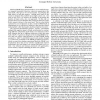Free Online Productivity Tools
i2Speak
i2Symbol
i2OCR
iTex2Img
iWeb2Print
iWeb2Shot
i2Type
iPdf2Split
iPdf2Merge
i2Bopomofo
i2Arabic
i2Style
i2Image
i2PDF
iLatex2Rtf
Sci2ools
ISCA
2012
IEEE
2012
IEEE
A case for exploiting subarray-level parallelism (SALP) in DRAM
Modern DRAMs have multiple banks to serve multiple memory requests in parallel. However, when two requests go to the same bank, they have to be served serially, exacerbating the high latency of off-chip memory. Adding more banks to the system to mitigate this problem incurs high system cost. Our goal in this work is to achieve the benefits of increasing the number of banks with a low cost approach. To this end, we propose three new mechanisms that overlap the latencies of different requests that go to the same bank. The key observation exploited by our mechanisms is that a modern DRAM bank is implemented as a collection of subarrays that operate largely independently while sharing few global peripheral structures. Our proposed mechanisms (SALP-1, SALP-2, and MASA) mitigate the negative impact of bank serialization by overlapping different components of the bank access latencies of multiple requests that go to different subarrays within the same bank. SALP-1 requires no changes to the...
Core Systems | Drams | Hardware | ISCA 2012 | Timing Parameters |
| Added | 28 Sep 2012 |
| Updated | 28 Sep 2012 |
| Type | Journal |
| Year | 2012 |
| Where | ISCA |
| Authors | Yoongu Kim, Vivek Seshadri, Donghyuk Lee, Jamie Liu, Onur Mutlu |
Comments (0)

